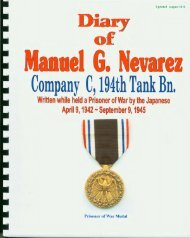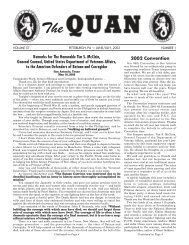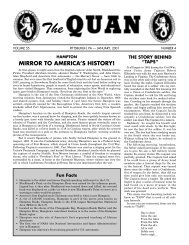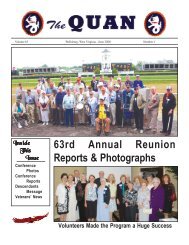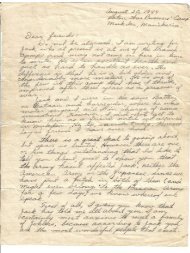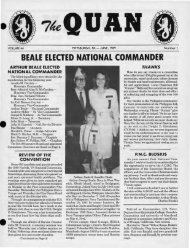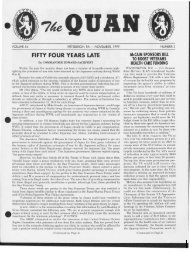Sept. 2003 - Philippine Defenders Main
Sept. 2003 - Philippine Defenders Main
Sept. 2003 - Philippine Defenders Main
You also want an ePaper? Increase the reach of your titles
YUMPU automatically turns print PDFs into web optimized ePapers that Google loves.
Operation Olympic<br />
An invasion not found in history books<br />
By James Martin Davis<br />
Deep in the recesses of the National Archives in<br />
Washington, D.C., hidden for nearly four decades, lie thousands<br />
of pages of yellowing and dusty documents stamped<br />
“Top Secret.” These documents, now declassified, are the<br />
plans for Operation Downfall, the invasion of Japan during<br />
World War II.<br />
Only a few Americans in 1945 were aware of the elaborate<br />
plans that had been prepared for the Allied invasion of the<br />
Japanese home islands. Even fewer today are aware of the<br />
defenses the Japanese had prepared to counter the invasion<br />
had it been launched.<br />
Operation Downfall was finalized during the spring and<br />
summer of 1945. It called for two massive military undertakings<br />
to be carried out in succession and aimed at the heart of the<br />
Japanese Empire.<br />
4 — THE QUAN<br />
Olympic<br />
In the first invasion — code-named Operation Olympic —<br />
American combat troops would land on Japan by amphibious<br />
assault during the early morning hours of Nov. 1, 1945 — 58<br />
years ago. Fourteen combat divisions of soldiers and Marines<br />
would land on heavily fortified and defended Kyushu, the<br />
southernmost of the Japanese home islands after an unprecedented<br />
naval and aerial bombardment.<br />
Coronet<br />
The second invasion March 1, 1946 — code-named<br />
Operation Coronet — would send at least 22 combat divisions<br />
against 1 million Japanese defenders on the main island of<br />
Honshu and the Tokyo Plain. Its goal: the unconditional surrender<br />
of Japan.<br />
With the exception of a part of the British Pacific Fleet,<br />
Operation Downfall was to be a strictly American operation. It<br />
called for using the entire Marine Corps, the entire Pacific<br />
Navy, and elements of the 8th Army Air force, the 8th Air Force<br />
(recently deployed from Europe), the 20th Air Force and the<br />
American Far Eastern Air Force.<br />
More than 1.5 million combat soldiers, with 3 million more<br />
in support — more than 40 percent of all servicemen still in uniform<br />
in 1945 — would be directly involved in he two amphibious<br />
assaults.<br />
Casualties were expected to be extremely heavy.<br />
Admiral William Leahy estimated that there would be more<br />
than 250,000 Americans killed or wounded on Kyushu alone.<br />
Gen. Charles Willoughby, chief of intelligence for Gen. Douglas<br />
MacArthur, the Supreme Commander of the Southwest Pacific,<br />
estimated American casualties from the entire operation would<br />
be 1 million men by the fall of 1946. Willoughby’s own intelligence<br />
staff considered this to be a conservative estimate.<br />
During the summer of 1945, America had little time to prepare<br />
for such an endeavor, but top military leaders were in<br />
almost unanimous agreement that an invasion was necessary.<br />
While a naval blockade and strategic bombing of Japan<br />
was considered to be useful, MacArthur, for instance, did not<br />
believe a blockade would bring about an unconditional surrender.<br />
The advocates for invasion agreed that while a naval<br />
blockade chokes, it does not kill; and though strategic bombing<br />
might destroy cities, it leaves whole armies intact.<br />
So on May 25, 1945, the Joint Chiefs of Staff, after extensive<br />
deliberation, issued to MacArthur, Admiral Chester Nimitz<br />
and Army Air Force Gen. Henry “Hap” Arnold, the top secret<br />
directive to proceed with the invasion of Kyushu.<br />
The target date was set for after the typhoon season.<br />
Surrender<br />
President Truman approved the plans for invasions July 24.<br />
Two days later the United Nations issued the Potsdam<br />
Proclamation, which called upon Japan to surrender unconditionally<br />
or face total destruction. Three days later, the Japanese<br />
governmental news agency broadcast to the world that Japan<br />
would ignore the proclamation and would refuse to surrender.<br />
During this same period it was learned — via monitoring<br />
Japanese radio broadcasts — that Japan had closed all schools<br />
and mobilized its school children, was arming its civilian population<br />
and was fortifying caves and building underground facilities.<br />
Operation Olympic called for a four-pronged assault on<br />
Kyushu. Its purpose was to seize and control the southern<br />
one-third of that island and establish naval and air bases, to<br />
tighten the naval blockade of the home islands, to destroy units<br />
of the main Japanese army and to support the later invasion of<br />
the Tokyo Plain.<br />
The preliminary invasion would begin Oct. 27 when the<br />
40th Infantry Division would land on a series of small islands<br />
west and southwest of Kyushu. At the same time, the 158th<br />
Regimental Combat Team would invade and occupy a small<br />
island 28 miles south of Kyushu.<br />
On these islands, seaplane bases would be established<br />
and radar would be set up to provide advance air warning for<br />
the invasion fleet, to serve as fighter direction centers for the<br />
carrier-based aircraft and to provide an emergency anchorage<br />
for the invasion fleet, should things not go well on the day of<br />
the invasion.<br />
Navy<br />
As the invasion grew imminent, the massive power of the<br />
Navy — the Third and Fifth Fleets — would approach Japan.<br />
the Third Fleet, under Admiral William “Bull” Halsey, with<br />
its big guns and naval aircraft, would provide strategic support<br />
for the operation against Honshu and Hokkaido.<br />
Halsey’s fleet would be composed of battleships, heavy<br />
cruisers, destroyers, dozens of support ships and three fast<br />
carrier task groups. From these carriers, hundreds of Navy<br />
fighters, dive bombers and torpedo planes would hit targets all<br />
over the island of Honshu.<br />
The 3,000-ship Fifth Fleet, under Admiral Raymond<br />
Spruance, would carry the invasion troops.<br />
Several days before the invasion, the battleships, heavy<br />
cruisers and destroyers would pour thousands of tons of high<br />
explosives into the target areas. They would not cease the<br />
bombardment until after the landing forces had been launched.<br />
During the early morning hours of Nov. 1 the invasions<br />
would begin. Thousands of soldiers and marines would pour<br />
ashore on beaches all along the eastern, southeastern, southern<br />
and western coasts of Kyushu.<br />
Waves of Helldivers, Dauntless dive bombers, Avengers,<br />
Corsairs and Hellcats from 66 aircraft carriers would bomb,<br />
rocket and strafe enemy defenses, gun emplacements and<br />
troop concentrations along the beaches.<br />
Beach names<br />
The Eastern Assault Force, consisting of the 25th, 33rd<br />
and 41st Infantry Divisions, would land near Miyasaki, at<br />
beaches called Austin, Buick, Cadillac, Chevrolet, Chrysler and<br />
Cord and move inland to attempt to capture the city and its<br />
nearby airfield.<br />
The Southern Force, consisting of the 1st Cavalry<br />
Division, the 43rd Division and Americal Division would land<br />
inside Ariake Bay at beaches labeled DeSoto, Dusenberg,<br />
Essex, Ford and Franklin and attempt to capture Shibushi and<br />
to capture the city of Kanoya and its airfield.<br />
On the western shore of Kyushu, at beaches Pontiac,<br />
Reo, Rolls Royce, Saxon, Star, Studebaker, Stutz, Winton and<br />
Zephyr, the V Amphibious Corps would land the 2nd, 3rd and<br />
(Continued on Page 5)



